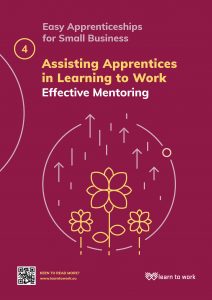Effective Introductions to your Business
Onboarding Apprentices
Easy Apprenticeships for Small Business

The added value of a good onboarding phase is to allow everyone involved to feel comfortable around each other to start working and producing from the earliest stage.
It is important that a company establishes informed and trusting relationships with apprentices from the first day. This is to ensure everyone knows how to move around and what to expect from each other. Also, it will assure these expectations will be fulfilled efficiently during the timeframe of the apprenticeship.
The way the introduction is made varies from company to company according to their culture and industry, as well as the nature of the apprenticeship itself. This booklet outlines how to design an effective onboarding.
First impressions matter – apprentices who are properly introduced to a company are likely to enthusiastically align themselves with the company’s mission, vision and values. This brings additional benefits including that:
- the majority of apprentices stay in employment with the same employer after finishing an apprenticeship, many of whom are promoted within 12 months of finishing;
- enthusiastic apprentices promote a better image of the company amongst their peers, and amongst the company’s clients;
- motivated apprentices increase staff retention levels and improve staff morale.
“Allow the apprentice to familiarise”
The issue of ‘irrelevant’ apprenticeships where students are asked to ‘copy and scan documents’ is exactly what should be avoided. These miss out on key benefits of apprenticeships, in particular knowledge transfer and potential value created by apprentices for the company as well as improved recruitment among others.
“Apprentices are unexperienced to perform serious tasks”
Students shouldn’t be considered as young and inexperienced but rather as motivated and eager to learn, which pushes them to learn and perform well in their apprenticeship. Although self-evident it is often overlooked fact that the better we prepare and train the apprentices, better they will perform in their tasks which are of course a part of company’s daily work.
In designing procedures for onboarding apprentices, SMEs should follow these key steps:
- Introduce your company to the apprentice. Allocate enough dedicated time to welcome the apprentice on the first day. Supply enough materials to the apprentice with information and documentation about your company, its portfolio of past, present and future products and/or services and your company’s strategy.
- Provide the apprentice with the necessary practicalities. This might include an overview and guided-visit of the infrastructure; the company schedules and house rules; any relevant safety instructions and protective equipment needed; a personalized email address and access codes needed to start working, etc.
- Create an onboarding plan to ensure a comprehensive experience. Create a formal plan covering what the apprentice should know, who they should meet, and which parts of the company they should visit to understand your company. Create a timeline for these activities, and share this information with staff dealing with the apprentice.
- Introduce the apprentice and his/her placement to your staff and vice-versa. While escorting the apprentice on the guided visit to the company facilities, take the opportunity to introduce them and their placement to all your staff. This will give them the opportunity to get to know each other from the earliest stage and open doors for future collaboration between them.
The apprentice needs to know the key staff of your company and their job roles, so they know how to move around and whom to address for different issues. On the other hand, your staff should have to have a clear idea of the placement, so they know what outputs to expect from the apprentice and how to collaborate with and mentor them. This will avoid unnecessary delays in the communication and in the performance of the tasks, compromising the outcomes of the placement on both ends.
Allow the apprentice to familiarise with and integrate him/herself in your company’s internal culture. The apprentice may arrive very well prepared academically, but keep in mind they may have no prior work experience and that the world of work might be completely new to them and will need some time to adjust to the working environment and to your internal culture. Each organization has an internal culture of their own, so it is very important that this is passed on to the apprentice. The sooner they understand your cultural context, the smother the integration will be.
Integrate the Apprentice into the Social Life of the Company – whether the social-life of the company involves chat around the watercooler or after-work beers at the weekend, be sure to invite the apprentice to them, to ensure they feel included. Encourage the apprentice to organise their own ‘get to know me’ event.
Test and validate with the apprentice the adequacy of any infrastructure (facilities, equipment, etc.) that you have prepared in advance of onboarding her/him and to adapt them as needed, based on her/his inputs.
Every person with special needs should feel in the safe zone while working at the SME. This means that not just mentor but also all the other employees should be aware of the needs of the apprentice and interact with them in an accessible manner.
Further information is provided at https://learntowork.eu/special-needs











